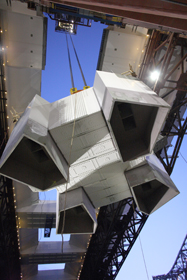Bridge officials have unveiled a plan to accelerate the opening of the new East Span of the San Francisco-Oakland Bay Bridge by four to six months, allowing the bridge to open in both directions in the fall of 2013.

An underneath view of the grillage piece as it rises between the twin decks of the East Span. Photo by Bill Hall, Caltrans
“We want seismic safety sooner,” said Caltrans spokesman Bart Ney. “By realigning traffic now, we can accelerate construction and open the Bay Bridge to all motorists in 2013.”
The original bridge’s westbound lanes on the Oakland side are directly in the path of yet-to-be-completed eastbound lanes of the new span along a 1,000-foot-long stretch of road known as the Oakland Touchdown. The previous opening plan involved shifting westbound traffic to the new span in 2013, and then taking an additional four to six months to demolish the conflicting structure and finish the new eastbound roadway.
The recently announced bypass plan entails implementing detours for the next two years; eastbound traffic will be shifted to its detour in late May 2011, while the westbound shift will occur in early 2012. The detours will allow construction crews to work between the existing and new bridges to complete the eastbound Oakland Touchdown over the next two and a half years.
According to Ney, there will be no full bridge closure associated with the eastbound alignment change in May. Caltrans is investigating whether a closure will be necessary for the westbound alignment change in 2012.
Meanwhile, work is continuing apace at the other end of the new Bay Bridge East Span, along the marquee self-anchored suspension span (SAS) adjacent to Yerba Buena Island. The SAS tower’s four legs reached their full 480-foot height when the fourth tier of legs was installed in March. Then in mid-April, crews installed a cap of sorts, known as the grillage, which brought the tower height to 495 feet.
Already, the tower is an imposing and dramatic presence for drivers crossing the existing Bay Bridge. A couple more crowning pieces down the road will bring the tower to its ultimate height of 525 feet above the Bay.
While crews have been erecting the tower here on the Bay, a fabrication facility in Shanghai has been putting the finishing touches on the final deck pieces for the SAS. Scheduled for shipment to the Bay Area this summer, the pieces will close the remaining gap between the SAS and the already completed Skyway portion of the new East Span, making for a continuous roadway from Yerba Buena Island to the touchdown in Oakland.
The East Span project is being overseen by the Toll Bridge Program Oversight Committee (TBPOC), made up of MTC’s Bay Area Toll Authority (BATA), Caltrans and the California Transportation Commission (CTC).

The Bay Bridge touchdown as it now exists, with the twin decks of the new East Span coming in from the right. © 2011 Barrie Rokeach www.rokeachphoto.com

A schematic showing how the detours will allow for the completion of the Bay Bridge East Span touchdown

